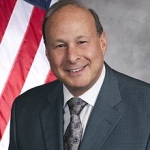The Origins of the Massachusetts Cultural Facilities Program: Try, try again...
Posted by Feb 07, 2017

Stan Rosenberg
How many times have you heard someone say “If at first you don’t succeed, try, try again”? Well, where I work, you hear it a lot!
This is the story of how the Massachusetts Cultural Facilities Program came into being. It’s a story created through patience, persistence, and opportunity.
It began as the mid-1990s approached, as a result of a constituent request for state assistance by the founder of the Yiddish Book Center, a nationally known cultural resource located on the campus of Hampshire College in Amherst, Massachusetts. Its founder, Aaron Lansky, started the Center as a Hampshire College student when he became interested in learning Yiddish, a pre-Holocaust German dialect used by Jewish residents of Eastern and Central European which combined German and Hebrew words. As a student, he started to collect Yiddish books and music, and before he knew it his collection filled a two story abandoned school. He decided that it was time to build a Center to house the collection and to present programming in Yiddish. Aaron set out to raise more than $6 million to build the new Center, which was designed to look like a Russian Shtetl (a small town).

I did what any good legislator would do: I checked around state government and found there was quite a need for capital assistance to build and renovate cultural assets all across the Commonwealth, but there was no appropriate, designated program to assist with these worthy projects.
A short time later, I filed a bill, and the process of making sausage began. Meetings were held, research was conducted, coalitions were organized, testimony was presented, strategies were crafted, legislators were lobbied, all to no avail. One term. Two terms. Three terms. Still no breakthrough.
Then, unexpectedly, the bill’s sponsor becomes chair of the budget committee and voilà, it’s a new day for this great idea! Within a term it is included in a version of an economic development bill. Alas, it does not make it through the process, and dies a painful death in the conference committee resolving the differences between the House and Senate.
Back to square one. File the bill again for the next term. And again the following term. Years pass. Still no progress.
A new Senate President and new Speaker of the House are elected. Those of us advocating for the arts urge them to create a legislative committee focused on arts policy. Looking for a potential signature achievement, these new leaders agree and the Committee on Tourism, Arts and Cultural Development is born.
Enter the Boston Foundation, a community foundation known for creating broad-based task forces to research and make recommendations on issues significant to Boston’s future, which names one on the arts. They produce a robust report making recommendations on many issues and opportunities. The number one issue? You guessed it, the need for state funding to address the capital improvement needs of Boston’s cultural assets. This report echoes the recommendations of a report produced earlier by the Massachusetts Cultural Council identifying a $1 billion statewide capital need.
Members of the Boston Foundation Board of Directors meet with key legislators and the state’s arts advocacy organization; a strategy is planned and a campaign for a cultural facilities program takes root.
The new Speaker looking for a first term signature accomplishment. A new legislative committee looking for a priority bill to focus on. A recently reorganized arts advocacy organization looking for a meaningful statewide initiative beyond the Cultural Council’s annual appropriation. Reliable research from the Cultural Council and the Boston Foundation. Business and government leadership working in concert. Key media echoing the message. What more to you need for success? Nothing!
In a matter of months, the bill was signed into law. We celebrate the 10th anniversary of that signing in 2017 knowing that as a result of that decade-long struggle, filled with ups and downs and too many turns in the road to count, that much has been accomplished, indeed.
The numbers tell the rest of the story.
In the first nine years of the program, there have been 201 planning grants averaging $25,000 each and 491 capital grants averaging $178,000, with the largest being $675,000. The $91.1 million spent by the Commonwealth of Massachusetts in these nine years leveraged a whopping $1.8 billion in private funds! That's a return of about 20 to 1! Who says a little can’t go a long way?
The range of projects have been impressive, from funding ADA projects making facilities more accessible, to repairing leaking roofs, installing new lighting and sound systems, and new marquees. Some used funding for projects as diverse as installing new seats and enlarging stages to accommodate larger productions. Helping to spur downtown economic development, major projects were launched to completely restore early 20th century movie theaters in performance centers and converting abandoned mills into art museums and artist live/work space.
And the number of jobs created? An impressive 23,778 in the trades and 2,100 permanent jobs in the cultural sector.
The moral of the story: with patience, persistence, and watching for opportunities that come with change, success will be just around the corner.
If at first you don’t succeed...





